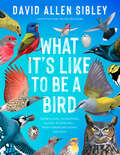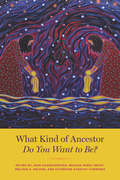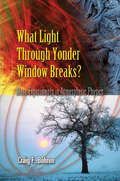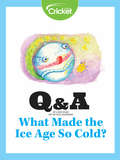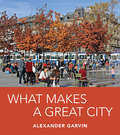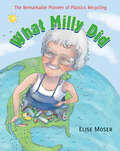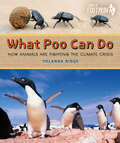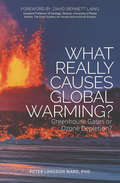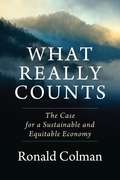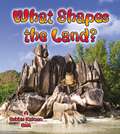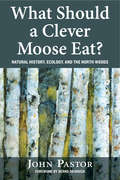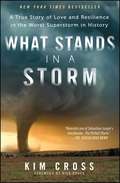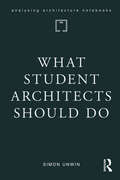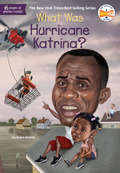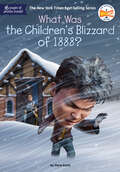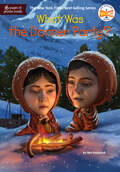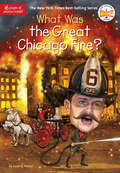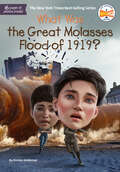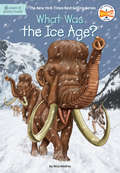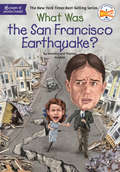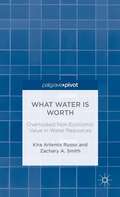- Table View
- List View
What It's Like to Be a Bird (Adapted for Young Readers): From Flying to Nesting, Eating to Singing--What Birds Are Doing and Why
by David Allen SibleyIn this edition for young readers adapted from the bestselling work written and illustrated by David Allen Sibley, readers will find a unique treasure trove of fascinating facts about birds, paired with more than 300 full-color illustrations—some life-size! The extraordinary world of birds is brought to life on the page. Did you know that many species of birds have sensory abilities that surpass those of humans? Or that some birds spend the entire winter in the air, and even sleep while flying? Have you ever wondered why birds have feathers? Or why they are a particular color? Have you noticed that some birdsong sounds like a musical scale?Maybe you&’re more interested in &“how&” questions: How do birds actually fly or swim? How and why do some birds migrate? How do they find food? How do they take care of their offspring?Birds are not only beautiful and fascinating, but they also serve an essential role in our ecosystem. This book shows how birds and humans are intrinsically connected, sometimes helping and sometimes hindering each other.Perfect for dedicated birdwatchers—or for anyone who simply delights in noticing birds in their neighborhood. Readers can explore, share, and return to the pages again and again, each time gaining a broader appreciation for our enchanting feathered friends.
What Kind of Ancestor Do You Want to Be?
by Melissa K. Nelson John Hausdoerffer Brooke Parry Hecht Katherine Kassouf CummingsAs we face an ever-more-fragmented world, What Kind of Ancestor Do You Want to Be? demands a return to the force of lineage—to spiritual, social, and ecological connections across time. It sparks a myriad of ageless-yet-urgent questions: How will I be remembered? What traditions do I want to continue? What cycles do I want to break? What new systems do I want to initiate for those yet-to-be-born? How do we endure? Published in association with the Center for Humans and Nature and interweaving essays, interviews, and poetry, this book brings together a thoughtful community of Indigenous and other voices—including Linda Hogan, Wendell Berry, Winona LaDuke, Vandana Shiva, Robin Kimmerer, and Wes Jackson—to explore what we want to give to our descendants. It is an offering to teachers who have come before and to those who will follow, a tool for healing our relationships with ourselves, with each other, and with our most powerful ancestors—the lands and waters that give and sustain all life.
What Light Through Yonder Window Breaks?: More Experiments in Atmospheric Physics
by Craig F. Bohren"Informative and engagingly idiosyncratic . . . brings the subject down to earth with offbeat, everyday examples and easy-to-follow experiments. . . . Both professionals and laymen can learn from this book."--The New York Times Book Review"A brilliant collection of intriguing examples of the physics of everyday phenomena, with the examples presented as puzzles."--Discover"A delightful book."--Bulletin of the American Meteorological SocietyThis is the sequel to Craig Bohren's popular Clouds in a Glass of Beer (also available from Dover), the book that made the fascinating world of atmospheric physics accessible to readers without a scientific background. Like its predecessor, this volume abounds in lively writing, fun-filled and easy-to-perform experiments, and numerous photographs and illustrations that offer illuminating and memorable ways to learn about an intriguing branch of science.
What Lives in a Shell? (Let's-Read-and-Find-Out Science 1)
by Kathleen Weidner ZoehfeldRead and find out about what lives in a shell in this colorfully illustrated nonfiction picture book.A house is a home for you, a nest is a home for a bird, and a cave is a home for a bear. But for some animals a shell is a home. Snails and turtles and crabs and clams all have shells that act as their homes and protect them from harm.This clear and appealing book for early elementary age kids, both at home and in the classroom, is a fascinating exploration of the many creatures that make a home in a shell. This picture book features beautifully accurate illustrations of the many types of shells—inside and out! Young readers will love exploring the fascinating homes of creatures like hermit crabs, scallops, and turtles.This is a Level 1 Let's-Read-and-Find-Out, which means the book explores introductory concepts perfect for children in the primary grades. The 100+ titles in this leading nonfiction series are:hands-on and visualacclaimed and trustedgreat for classroomsTop 10 reasons to love LRFOs:Entertain and educate at the same timeHave appealing, child-centered topicsDevelopmentally appropriate for emerging readersFocused; answering questions instead of using survey approachEmploy engaging picture book quality illustrationsUse simple charts and graphics to improve visual literacy skillsFeature hands-on activities to engage young scientistsMeet national science education standardsWritten/illustrated by award-winning authors/illustrators & vetted by an expert in the fieldOver 130 titles in print, meeting a wide range of kids' scientific interestsBooks in this series support the Common Core Learning Standards, Next Generation Science Standards, and the Science, Technology, Engineering, and Math (STEM) standards. Let's-Read-and-Find-Out is the winner of the American Association for the Advancement of Science/Subaru Science Books & Films Prize for Outstanding Science Series.
What Made the Ice Age So Cold?
by Lizzie WadeWhat made the ice age so cold? This Q & A defines the different ice ages of the Earth and when they come about.
What Makes Day and Night
by Franklyn M. Branley"What Makes Day and Night" goes through the cycle of the earth and its revolutions around the sun.
What Makes a Blizzard? (Let's-Read-and-Find-Out Science 2)
by Kathleen Weidner ZoehfeldRead and find out about blizzards in this colorfully illustrated nonfiction picture book.All blizzards are snowstorms, but not all snowstorms are blizzards. What is the difference? How much snow falls during a blizzard? How fast are the winds? How cold does it get during a blizzard? Read and find out! What Makes a Blizzard comes chock-full of visual aids like charts, sidebars, and hands-on activities—including how to keep a winter weather journal and how to observe what a snowflake really looks like.This is a clear and appealing science book for early elementary age kids, both at home and in the classroom. It's a Level 2 Let's-Read-and-Find-Out, which means the book explores more challenging concepts for children in the primary grades. The 100+ titles in this leading nonfiction series are:hands-on and visualacclaimed and trustedgreat for classroomsTop 10 reasons to love LRFOs:Entertain and educate at the same timeHave appealing, child-centered topicsDevelopmentally appropriate for emerging readersFocused; answering questions instead of using survey approachEmploy engaging picture book quality illustrationsUse simple charts and graphics to improve visual literacy skillsFeature hands-on activities to engage young scientistsMeet national science education standardsWritten/illustrated by award-winning authors/illustrators & vetted by an expert in the fieldOver 130 titles in print, meeting a wide range of kids' scientific interestsBooks in this series support the Common Core Learning Standards, Next Generation Science Standards, and the Science, Technology, Engineering, and Math (STEM) standards. Let's-Read-and-Find-Out is the winner of the American Association for the Advancement of Science/Subaru Science Books & Films Prize for Outstanding Science Series.
What Makes a Great City
by Alexander GarvinWhat makes a great city? City planner and architect Alexander Garvin set out to answer this question by observing cities, largely in North America and Europe, with special attention to Paris, London, New York, and Vienna.For Garvin, greatness is about what people who shape cities candotomakea city great. A great city is a dynamic, constantly changing place that residents and their leaders can reshape to satisfy their demands. Most importantly, it is about the interplay between people and public realm, and how they have interacted throughout history to create great cities.What Makes a Great Citywill help readers understand that any city can be changed for the better and inspire entrepreneurs, public officials, and city residents to do it themselves.
What Makes a Magnet? (Let's-Read-and-Find-Out Science 2 #Stage 2)
by Dr. Franklyn M. BranleyRead and find out about magnets in this colorfully illustrated nonfiction picture book.Why does a magnet pick up a paper clip but not a leaf or a penny? How can the whole world be a magnet?Follow the step-by-step instructions about how to make your own magnet, and then find out for yourself what makes a magnet!This is a clear and appealing science book for early elementary age kids, both at home and in the classroom. It's a Level 2 Let's-Read-and-Find-Out, which means the book explores more challenging concepts for children in the primary grades. The 100+ titles in this leading nonfiction series are:hands-on and visualacclaimed and trustedgreat for classroomsTop 10 reasons to love LRFOs:Entertain and educate at the same timeHave appealing, child-centered topicsDevelopmentally appropriate for emerging readersFocused; answering questions instead of using survey approachEmploy engaging picture book quality illustrationsUse simple charts and graphics to improve visual literacy skillsFeature hands-on activities to engage young scientistsMeet national science education standardsWritten/illustrated by award-winning authors/illustrators & vetted by an expert in the fieldOver 130 titles in print, meeting a wide range of kids' scientific interestsBooks in this series support the Common Core Learning Standards, Next Generation Science Standards, and the Science, Technology, Engineering, and Math (STEM) standards. Let's-Read-and-Find-Out is the winner of the American Association for the Advancement of Science/Subaru Science Books & Films Prize for Outstanding Science Series.
What Milly Did: The Remarkable Pioneer of Plastics Recycling
by Elise MoserThe extraordinary story of the woman who made plastics recycling possible. Milly Zantow wanted to solve the problem of her town’s full landfill and ended up creating a global recycling standard — the system of numbers you see inside the little triangle on plastics. This is the inspiring story of how she mobilized her community, creating sweeping change to help the environment. On a trip to Japan in 1978, Milly noticed that people were putting little bundles out on the street each morning. They were recycling — something that hadn’t taken hold in North America. When she returned to Sauk City, Wisconsin, she discovered that her town’s landfill was nearing capacity, and that plastic made up a large part of the garbage. No one was recycling plastics. Milly decided to figure out how. She discovered that there are more than seven kinds of plastic, and they can’t be combined for recycling, so she learned how to use various tests to identify them. Then she found a company willing to use recycled plastic, but the plastic would have to be ground up first. Milly and her friend bought a huge industrial grinder and established E-Z Recycling. They worked with local school children and their community, and they helped other communities start their own recycling programs. But Milly knew that the large-scale recycling of plastics would never work unless people could easily identify the seven types. She came up with the idea of placing an identifying number in the little recycling triangle, which has become the international standard. Milly's story is a glimpse into the early days of the recycling movement and shows how, thanks to her determination, hard work and community-building, huge changes took place, spreading rapidly across North America. Correlates to the Common Core State Standards in English Language Arts: CCSS.ELA-LITERACY.RI.3.3 Describe the relationship between a series of historical events, scientific ideas or concepts, or steps in technical procedures in a text, using language that pertains to time, sequence, and cause/effect. CCSS.ELA-LITERACY.RI.4.7 Interpret information presented visually, orally, or quantitatively (e.g., in charts, graphs, diagrams, time lines, animations, or interactive elements on Web pages) and explain how the information contributes to an understanding of the text in which it appears.
What Poo Can Do: How Animals Are Fighting the Climate Crisis (Orca Footprints #29)
by Yolanda RidgeWe all know animals are affected by the climate crisis. But did you know the climate crisis is also affected by animals? From whales to dung beetles, What Poo Can Do explores how animals big and small are helping the planet every time they do a number two. Come on a journey to different parts of the world to see how animals are fertilizing plants, storing carbon, preventing fires, reducing methane and even creating color-coded maps—all through their feces! Readers will discover how animal defecation makes a difference when it comes to the climate crisis. It's time to embrace the power of poo! The epub edition of this title is fully accessible.
What Really Causes Global Warming?: Greenhouse Gases or Ozone Depletion?
by Peter Langdon WardA thought-provoking look at the unsettled science of global warming—from a former volcanologist, geophysicist, and US Geological Survey scientist. Thousands of scientists are convinced beyond any reasonable doubt that recent global warming is being caused by emissions of greenhouse gases and that we must act immediately to reduce these emissions or else we may render Earth unlivable for our children and grandchildren. Some even say &“the science is settled.&” What Really Causes Global Warming? examines a broad range of observations that show that greenhouse warming theory is not only misguided, but not physically possible. Recent warming was caused by ozone depletion due to emissions of human-manufactured gases. We solved that problem with the Montreal Protocol on Substances that Deplete the Ozone Layer stopping the increase in global temperatures by 1998. Volcanoes also deplete ozone. The eruption of Bárðarbunga volcano in central Iceland from August 2014 to February 2015―the largest effusive, basaltic, volcanic eruption since 1783―caused 2015 to be the hottest year on record. How can we adapt?
What Really Counts: The Case for a Sustainable and Equitable Economy
by Ronald ColmanPoliticians and economists fixate on “growing the economy”—measured by a country’s gross domestic product. But this yardstick counts harmful activities such as greenhouse gas emissions, plastic waste, and cigarette sales as gains, and it ignores environmental protection, voluntary community work, and other benefits. What we measure is a choice, and what is and isn’t counted determines what sorts of policies are enacted. How can we shift the focus to well-being and quality of life?What Really Counts is an essential, firsthand story of the promise and challenges of accounting for social, economic, and environmental benefits and costs. Ronald Colman recounts two decades of working with three governments to adopt measures that more accurately and comprehensively assess true progress. Chronicling his path from Nova Scotia to New Zealand to Bhutan, Colman details the challenge of devising meaningful metrics, the effort to lay the foundations of a new economic system, and the obstacles that stand in the way. Reflecting on successes and failures, he considers how to shift policy priorities from a narrow economic-growth agenda toward a future built on sustainability and equity.Colman has taken the critique of GDP outside the academy and attempted to realize an alternative. The lessons he offers in What Really Counts are vital for anyone interested in how we can measure what matters—and how better measures can help build a better world.
What Shapes the Land ?
by Bobbie KalmanThe book talks about various interesting topics about the Earth like what are landforms, land shapers like water, air, fire, and other factors that affect the landforms like erosion, weathering etc.
What Should a Clever Moose Eat?: Natural History, Ecology, and the North Woods
by Bernd Heinrich John PastorHow long should a leaf live? When should blueberries ripen? And what shoulda clever moose eat? Questions like these may seem simple or downright strange--yet they form the backbone of natural history, a discipline that fostered some of our most important scientific theories, from natural selection to glaciation. Through careful, patient observations of the organisms that live in an area, their distributions, and how they interact with other species, we gain a more complete picture of the world around us, and our place in it.In What Should a Clever Moose Eat?, John Pastor explores the natural history of the North Woods, an immense and complex forest that stretches from the western shore of Lake Superior to the far coast of Newfoundland. The North Woods is one of the most ecologically and geologically interesting places on the planet, with a host of natural history questions arising from each spruce or sugar maple. From the geological history of the region to the shapes of leaves and the relationship between aspens, caterpillars, and predators, Pastor delves into a captivating range of topics as diverse as the North Woods themselves. Through his meticulous observations of the natural world, scientists and nonscientists alike learn to ask natural history questions and form their own theories, gaining a greater understanding of and love for the North Woods--and other natural places precious to them.In the tradition of Charles Darwin and Henry David Thoreau, John Pastor is a joyful observer of nature who makes sharp connections and moves deftly from observation to theory. Take a walk in John Pastor's North Woods--you'll come away with a new appreciation for details, for the game trails, beaver ponds, and patterns of growth around you, and won't look at the natural world in the same way again.
What Stands in a Storm: A True Story of Love and Resilience in the Worst Superstorm in History
by Kim CrossEnter the eye of the storm in this gripping real-life thriller—A Perfect Storm on land—that chronicles America’s biggest tornado outbreak since the beginning of recorded weather: a horrific three-day superstorm with 358 separate tornadoes touching down in twenty-one states and destroying entire towns.April 27, 2011 was the climax of a three-day superstorm that unleashed terror from Arkansas to New York. Entire communities were flattened, whole neighborhoods erased. Tornadoes left scars across the land so wide they could be seen from space. But from terrible destruction emerged everyday heroes—neighbors and strangers who rescued each other from hell on earth. “Armchair storm chasers will find much to savor in this grippingly detailed, real-time chronicle of nature gone awry” (Kirkus Reviews) set in Alabama, the heart of Dixie Alley where there are more tornado fatalities than anywhere else in the US. With powerful emotion and captivating detail, journalist Kim Cross expertly weaves together science and heartrending human stories. For some, it’s a story of survival; for others it’s the story of their last hours. Cross’s immersive reporting and dramatic storytelling catapult you to the center of the very worst hit areas, where thousands of ordinary people witnessed the sky falling around them. Yet from the disaster rises a redemptive message that’s just as real: in times of trouble, the things that tear our world apart reveal what holds us together.
What Student Architects Should Do (Analysing Architecture Notebooks)
by Simon UnwinAs a first year student the challenges of learning how to do architecture can be daunting. Though not prescribing a particular way (there are as many ways to do architecture as there are architects), this Notebook outlines what you should do to cultivate your own distinctive capacity for architectural design.Architecture is a rich and varied subject, a multifaceted and multidimensional skill. Learning to do it is not easy. It has many subtleties. Becoming fluent can take many years. Informed by decades of discussing architecture and its challenges with students, this Notebook will help you lay foundations for a rewarding career as a creative architect.All Simon Unwin’s books explore architecture not just as a matter of form and space but in terms of its primal driving force, the universal need and desire to make places for life.Each of these Analysing Architecture Notebooks is devoted to a particular theme in understanding the rich and varied workings of architecture. They can be thought of as addenda to the foundation volume Analysing Architecture: the Universal Language of Place-Making, which first appeared in 1997 and has subsequently been enlarged in four further editions. Examining these extra themes as a series of Notebooks, rather than as additional chapters in future editions, allows greater space for more detailed exploration of a wider variety of examples, whilst avoiding the risk of the original book becoming unwieldy.
What Was Hurricane Katrina? (What Was?)
by Robin Koontz John Hinderliter Kevin McveighOn August 25th, 2005, one of the deadliest and most destructive hurricanes in history hit the Gulf of Mexico. High winds and rain pummeled coastal communities, including the City of New Orleans, which was left under 15 feet of water in some areas after the levees burst. Track this powerful storm from start to finish, from rescue efforts large and small to storm survivors' tales of triumph.
What Was the Children's Blizzard of 1888? (What Was?)
by Steve Korté Who HQLearn about the deadly and unexpected blizzard that slammed the Midwestern United States in 1888 and doomed many young lives in this addition to the New York Times Bestselling What Was? series.On January 12, 1888, a surprise blizzard broke out in the middle of the day across the Midwest. In its path, hundreds of children and teachers found themselves stranded inside schoolhouses with no food, no heat, and very few options. Days passed, and over 235 people died as result of the harsh snow of the Schoolhouse Blizzard, but many were able to survive thanks to the bravery of others in their communities. Learn all about the disastrous weather conditions and the people who were affected by it in this book for young readers.
What Was the Donner Party? (What Was?)
by Ben Hubbard Who HQLearn about the treacherous journey across the Sierra Nevada mountain range that isolated and trapped a group of pioneers heading to California for an entire winter in this latest addition to the New York Times Bestselling What Was? series.In the winter of 1846-47, a group of eighty-seven pioneers heading from the Midwest to California found themselves snowbound in the Sierra Nevada mountain range with no way forward and no food or supplies. While forty-eight of the group members survived, the others perished due to extreme weather, starvation, and illness. To survive, the remaining people resorted to extreme measures...including cannibalism. Learn about the many miscalculations, bad decisions, and extreme weather that led to the demise of nearly half of the Donner Party in this book for young readers about one of California's first major disasters.
What Was the Great Chicago Fire? (What Was?)
by Janet PascalDid the Great Chicago Fire really start after a cow kicked over a lantern in a barn? Find out the truth in this addition to the What Was? series.On Sunday, October 8, 1871, a fire started on the south side of Chicago. A long drought made the neighborhood go up in flames. And practically everything that could go wrong did. Firemen first went to the wrong location. Fierce winds helped the blaze jump the Chicago River twice. The Chicago Waterworks burned down, making it impossible to fight the fire. Finally after two days, Mother Nature took over, with rain smothering the flames. This overview of a stupendous disaster not only covers the fire but explores the whole history of fire fighting. From the Trade Paperback edition.
What Was the Great Molasses Flood of 1919? (What Was?)
by Kirsten Anderson Who HQLearn about Boston's molasses disaster of 1919, when a storage tank burst and flooded the streets, in this latest addition to the New York Times Bestselling What Was? series.An unusually warm winter day resulted in 2.3 million gallons of molasses flooding the North End neighborhood of Boston, Massachusetts. The disaster killed twenty-one people and injured 150 others. Rescue missions were launched to save people from the sticky and deadly mess, led by the Red Cross, the Army, the Navy, and the Massachusetts Nautical School. With the help of hundreds of volunteers over the course of several weeks, the streets were cleaned up. But the smell of molasses and the horror of the preventable tragedy lingered for decades to come.
What Was the Ice Age? (What Was?)
by Nico Medina David Groff Who HqA mesmerizing overview of the world as it was when glaciers covered the earth and long-extinct creatures like the woolly mammoths and saber-toothed cats battled to survive.Go back 20,000 years ago to a time of much colder global temperatures when glaciers and extensive sheets of ice covered much of our planet. As these sheets traveled, they caused enormous changes in the Earth's landscape and climate, leading to the evolution of creatures such as giant armadillos, saber-toothed cats, and woolly mammoths as well as club-wielding Neanderthals and later the cleverer modern humans. Nico Medina re-creates this harsh ancient world in a vivid and easy-to-read narrative.
What Was the San Francisco Earthquake? (What Was?)
by Dorothy Hoobler Thomas Hoobler Ted HammondIn this addition to the What Was? series, kids will experience what it was like to be in San Francisco in 1906 when the ground buckled in a major, catastrophic earthquake.One early April morning in 1906, the people of San Francisco were jolted awake by a mammoth earthquake--one that registered 7.8 on the Richter Scale. Not only was there major damage from the quake itself but broken gas lines sparked a fire that ravaged the city for days. More than 500 city blocks were destroyed and over 200,000 people were left homeless. But the city quickly managed to rebuild, rising from the ashes to become the major tourist destination it is today. Here's an exciting recount of an incredible disaster.From the Trade Paperback edition.
What Water Is Worth: Overlooked Non-Economic Value in Water Resources
by Zachary A. Smith Kira Artemis RussoThis book addresses both conventional and non-conventional values of water, discussing the value of water as it relates to conventional microeconomics, water's true utility and government regulation, and new and current practices in water management
